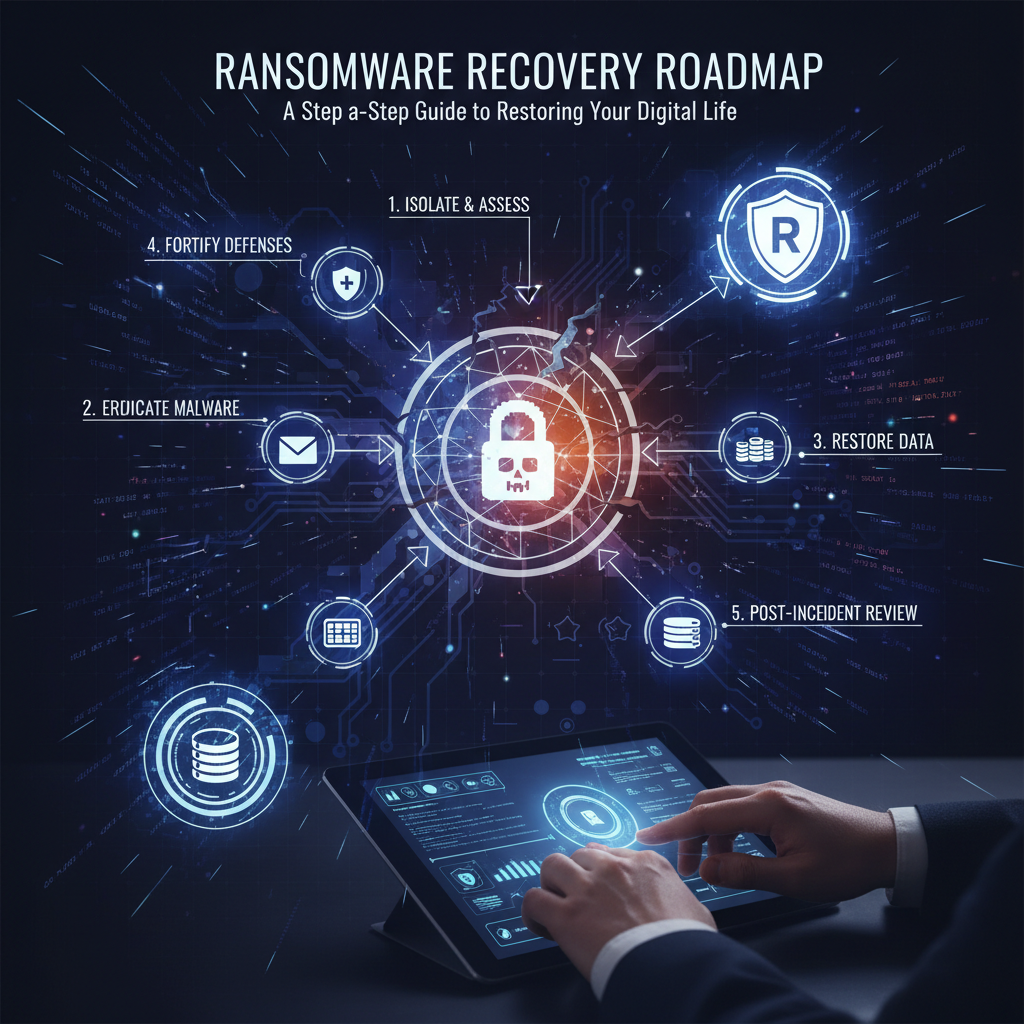For anyone who's lying awake refreshing bank alerts, a remote worker guarding client data, or a small business owner who just got a breach notice — you’re not alone. The constant fear of identity theft, the headaches of patching systems, and the shame or confusion after a data leak can make you feel trapped, powerless, and exhausted. Our team helps people exactly like you by combining practical data breach recovery steps with mental-health-first strategies so you can restore security and calm (without spinning in circles). Learn more about data breach recovery. Learn more about mental-health-first strategies.
What is cybersecurity anxiety?
Cybersecurity anxiety is the persistent worry, hypervigilance, or avoidance that comes from threats to your digital life — think passwords, accounts, devices, or private data. It's a form of digital stress that shows up as intrusive thoughts ("Did I click that link?"), compulsive checking, and a sense that the online world is unsafe. Learn more about digital stress.
I've noticed people describe it like a low-level panic that never goes away — and that’s real. It’s not just "being careful." It's a mental load that affects sleep, work, and relationships.
Why do people develop it after a data breach?
Short answer: loss of control. When your data is exposed you lose certainty — about identity, finances, and privacy. That uncertainty sparks a constant need to monitor and respond. Learn more about what to do after a data breach.
- Sudden exposure — even an email leak — can trigger intrusive checking every 15 minutes (yes, I’ve seen 12 checks per hour).
- Financial threat — the fear of fraudulent charges or loan applications keeps people up at night.
- Reputation worry — businesses fear customer trust erosion, which raises stress for owners and employees.
How does digital stress affect your mental health?
Digital stress bleeds into real life. You're less productive, more irritable, and you may avoid online tasks that used to be simple (like paying bills). Sleep suffers. So does your ability to focus.
And because the internet never sleeps, the anxiety often doesn't either — which makes everything worse, faster.
Signs you’re experiencing cybersecurity anxiety
- Checking accounts or security settings 10+ times per day.
- Avoiding online banking or communication tools because you’re afraid of clicks or leaks.
- Racing thoughts about identity theft, even with no evidence.
- Physical symptoms: headaches, stomach knots, trembling hands when dealing with security tasks.
- Procrastination on updates because “it’s too much” (this is common — you're not lazy).
How to manage cybersecurity anxiety — immediate steps
When panic hits, you need concrete moves. Quick wins reduce helplessness and lower stress fast. Do these in the first 48 hours if possible.
- Change passwords on affected accounts — use a passphrase, not "Password123".
- Enable 2-factor authentication (2FA) everywhere — authenticator apps are better than SMS.
- Check bank/credit statements and flag suspicious transactions within 24 hours.
- Freeze credit if sensitive personal data was exposed (this can stop new credit in its tracks).
- Document everything — dates, emails, screenshots. This helps recovery and lowers uncertainty.
Why these? Because action reduces the unknown. And the unknown is the fuel for anxiety.
How to manage cybersecurity anxiety — psychological strategies
Security actions help, but they don’t fix the emotional load. You need both.
- Limit checking: set scheduled check-ins (once in the morning, once in the evening). Stick to it — you’ll feel calmer within 7 days.
- Practice grounding: 4-4-8 breathing for 2 minutes before you open security emails (simple but powerful).
- Reframe the story: instead of "I failed," try "I caught this and I’m taking steps" — language matters.
- Talk to someone — a friend, a peer group, or a counselor. Isolation magnifies fear. From what I’ve seen, 3 conversations in the first week reduce shame dramatically.
- Consider brief CBT-style techniques (thought records, exposure to triggers) — they work for compulsive checking.
What to do after a data breach: a practical recovery checklist
Data breach recovery is both technical and administrative. Follow a checklist — it prevents missed steps and gives you control.
- Identify scope: which accounts or systems were affected? Make a list within 24–48 hours.
- Contain and secure: change passwords, rotate keys, remove compromised access.
- Notify affected people if you're responsible for their data. Honesty builds trust quickly (be clear about steps you’ve taken).
- Contact banks and card issuers — ask for fraud alerts or charge reversals within 30 days if applicable.
- File reports: file an identity theft report if personal data was stolen and report to regulators if required for businesses.
- Set up long-term monitoring: identity monitoring or credit alerts for 12 months (or longer, depending on the breach).
- Backup and rebuild: restore safe backups, patch vulnerabilities, and run a post-mortem to stop repeat incidents.
This is a lot. If this feels overwhelming, our team can handle the technical cleanup, coordinate notifications, and refer you to mental-health resources — so you don’t have to juggle everything alone.
Tools and services that actually reduce digital stress
Technology can be a relief, not another source of worry — if you pick the right tools.
- Password managers (1Password, Bitwarden, LastPass) — one strong master password replaces dozens of weak ones.
- Authenticator apps (Authy, Google Authenticator) — ditch SMS where possible.
- Identity monitoring services — they alert you to suspicious use of your SSN or credit in real time.
- VPNs for public Wi‑Fi — they don’t solve everything, but they lower attack surface for travel and cafes.
- Managed security services — for small businesses, outsourcing patching and monitoring reduces the mental load dramatically.
Pick one tool for authentication, one for passwords, and one monitoring service. Fewer moving parts = less mental friction.
Preventive habits for healthier online well‑being
Prevention keeps anxiety from returning. Build habits you can stick with.
- Update devices and apps once per week — schedule automatic updates where possible.
- Back up data weekly (and test restores quarterly).
- Use credit freezes and fraud alerts proactively if you’re high-risk.
- Set notification limits: email filters, critical-only banking alerts, and a single app for security alerts.
- Digital sabbaticals: one full day offline per month to reset your stress response (yes, you'll survive).
DIY, managed security, or therapy — which option is right?
Quick comparison — pick what matches your resources and stress level. Think of it like choosing between a Ferrari and a bicycle; either can get you where you need to go, but one requires more skill and upkeep.
DIY (you handle everything)
- Pros: cheaper, immediate control.
- Cons: high mental load; easy to miss steps; stressful during a breach.
- Best if: you have time, tech confidence, and low anxiety about delegating.
Managed security services (outsourced)
- Pros: expert monitoring, less day-to-day worry, faster containment.
- Cons: cost, trust/reliability considerations.
- Best if: you run a business, manage others' data, or you need to offload responsibility so you can sleep.
Therapy or coaching
- Pros: addresses the root of compulsive behaviors and panic; sustainable mental-health gains.
- Cons: takes time (but it’s worth it).
- Best if: anxiety persists despite technical fixes, or you’re avoiding life tasks because of digital fear.
In my opinion, the best outcomes mix managed security with short-term therapy — technical fixes plus mental tools. You fix the problem and your reaction to it. Both matter.
Quick recovery timeline you can rely on
Concrete timelines reduce rumination. Here’s a simple one to follow after a breach:
- 0–48 hours: Contain, change passwords, enable 2FA, document scope.
- 3–7 days: Notify banks/clients, set fraud alerts, start credit monitoring.
- 7–30 days: Complete forensic review (if needed), patch systems, notify regulators/customers.
- 30–90 days: Monitor for fraud, adjust processes, schedule follow-up security audits.
Final thoughts — digital well‑being is a skill, not luck
Look, anxiety about hacks or breaches is normal. But you don’t have to live in it. Practical security steps reduce the chance of future incidents, and mental-health techniques reduce your suffering now. The combination is powerful — and repeatable.
If you're feeling overwhelmed, our team can handle the technical cleanup and connect you with clinicians who understand cyber-related stress — letting you focus on what matters most, not on every alert blip.
Frequently asked questions
What is the difference between cybersecurity anxiety and general anxiety?
Cybersecurity anxiety is specifically triggered by digital threats — accounts, passwords, data, and devices. General anxiety is broader (work, relationships, health). The treatments overlap, but addressing the security source (patching, monitoring) is a key additional step for cybersecurity anxiety.
Can a data breach cause long-term mental health problems?
Yes, for some people. Persistent sleep problems, hypervigilance, and avoidance can last months if unaddressed. Early action (technical cleanup + short-term therapy) dramatically lowers the risk of long-term problems.
How long does data breach recovery usually take?
Initial containment and password changes can happen in 48 hours. Full recovery — including monitoring, forensic review, and restoring trust — often takes 30–90 days, depending on severity. Some monitoring should continue for 12 months or more if personal data was exposed.
When should I seek professional help for cybersecurity anxiety?
Seek help if your checking behaviors interfere with work, relationships, or sleep, or if you feel immobilized. If you’ve been compulsively checking 10+ times per day for more than two weeks, it's time to talk to a counselor or a security professional.
Are password managers and 2FA enough to stop cybersecurity anxiety?
They’re a huge step and they cut real risk, which lowers anxiety. But they’re not a cure. Combine them with limits on checking, grounding techniques, and, if needed, counseling for the best results.


